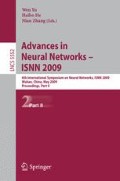Abstract
Data envelopment analysis (DEA) is an effective method for measuring the relative efficiency of a set of homogeneous decision-making units (DMUs). However, the data in traditional DEA model are limited to crisp inputs and outputs, which cannot be precisely obtained in many production processes or social activities. This paper attempts to extend the traditional DEA model and establishes a DEA model with type-2 (T2) fuzzy inputs and outputs. To establish this model, we first propose a reduction method for T2 fuzzy variables based on the expected value of fuzzy variable. After that, we establish a DEA model with the obtained fuzzy variables. In some special cases such as the inputs and outputs are independent T2 triangular fuzzy variables, we provide a method to turn the original DEA model to its equivalent one. At last, we provide a numerical example to illustrate the efficiency of the proposed DEA model.
Access this chapter
Tax calculation will be finalised at checkout
Purchases are for personal use only
Preview
Unable to display preview. Download preview PDF.
References
Charnes, A., Cooper, W.W., Rhodes, E.: Measuring the Efficiency of Decision Making Units. European Journal of Operational Research 6, 429–444 (1978)
Banker, R.D., Charnes, A., Cooper, W.W.: Some Models for Estimating Technical and Scale Inefficiencies in Data Envelopment Analysis. Management Science 30, 1078–1092 (1984)
Petersen, N.C.: Data Envelopment Analysis on a Relaxed Set of Assumptions. Management Science 36, 305–313 (1990)
Tone, K.: A Slack-Based Measure of Efficiency in Data Envelopment Analysis. European Journal of Operational Research 130, 498–509 (2001)
Bauer, P.W.: Recent Developments in the Econometric Estimation of Frontiers. Journal of Econometrics 46, 39–56 (1990)
Cooper, W.W., Huang, Z.M., Li, S.X.: Satisfying DEA Models under Chance Constraints. Annals of Operations Research 66, 279–295 (1996)
Cooper, W.W., Seiford, L.M., Tone, K.: Data Envelopment Analysis. Springer Science and Business Media, LLC (2007)
Sengupta, J.K.: A Fuzzy Systems Approach in Data Envelopment Analysis. Computers & Mathematics with Applications 24, 259–266 (1992)
Zadeh, L.A.: Concept of a Linguistic Variable and Its Application to Approximate Reasoning–I. Information Sciences 8, 199–249 (1975)
Mitchell, H.: Ranking Type-2 Fuzzy Numbers. IEEE Tansactions on Fuzzy Systems 14, 327–348 (2006)
Zeng, J., Liu, Z.Q.: Type-2 Fuzzy Sets for Pattern Recognition: the State-of-the-Art. Journal of Uncertain Systems 1, 163–177 (2007)
Liu, Z.Q., Liu, Y.K.: Fuzzy Possibility Space and Type-2 Fuzzy Variable. In: Proc. of IEEE Symp. Found. Comput. Intell., Piscataway, NJ, pp. 616–621 (2007)
Driankov, D., Hellendoorn, H., Reinfrank, M.: An Introduction to Fuzzy Control. Springer, Berlin (1996)
Karnik, N.N., Mendel, J.M.: Centroid of a Type-2 Fuzzy Set. Information Sciences 132, 195–220 (2001)
Liu, B., Liu, Y.K.: Expected Value of Fuzzy Variable and Fuzzy Expected Value Models. IEEE Transactions on Fuzzy Systems 10, 445–450 (2002)
Liu, Y.K., Gao, J.: The Independence of Fuzzy Variables with Applications to Fuzzy Random Optimization. International Journal of Uncertainty, Fuzziness & Knowledge-Based Systems 15(suppl. 2), 1–20 (2007)
Liu, B.: Theory and Practice of Uncertain Programming. Physica-Verlag, Heidelberg (2002)
Wang, S., Liu, Y., Dai, X.D.: On the Continuity and Absolute Continuity of Credibility Functions. Journal of Uncertain Systems 1, 185–200 (2007)
Liu, Y.K., Wang, S.: Theory of Fuzzy Random Optimization. China Agricultural University Press, Beijing (2006)
Author information
Authors and Affiliations
Editor information
Editors and Affiliations
Rights and permissions
Copyright information
© 2009 Springer-Verlag Berlin Heidelberg
About this paper
Cite this paper
Qin, R., Liu, Y., Liu, Z., Wang, G. (2009). Modeling Fuzzy DEA with Type-2 Fuzzy Variable Coefficients. In: Yu, W., He, H., Zhang, N. (eds) Advances in Neural Networks – ISNN 2009. ISNN 2009. Lecture Notes in Computer Science, vol 5552. Springer, Berlin, Heidelberg. https://doi.org/10.1007/978-3-642-01510-6_4
Download citation
DOI: https://doi.org/10.1007/978-3-642-01510-6_4
Publisher Name: Springer, Berlin, Heidelberg
Print ISBN: 978-3-642-01509-0
Online ISBN: 978-3-642-01510-6
eBook Packages: Computer ScienceComputer Science (R0)

